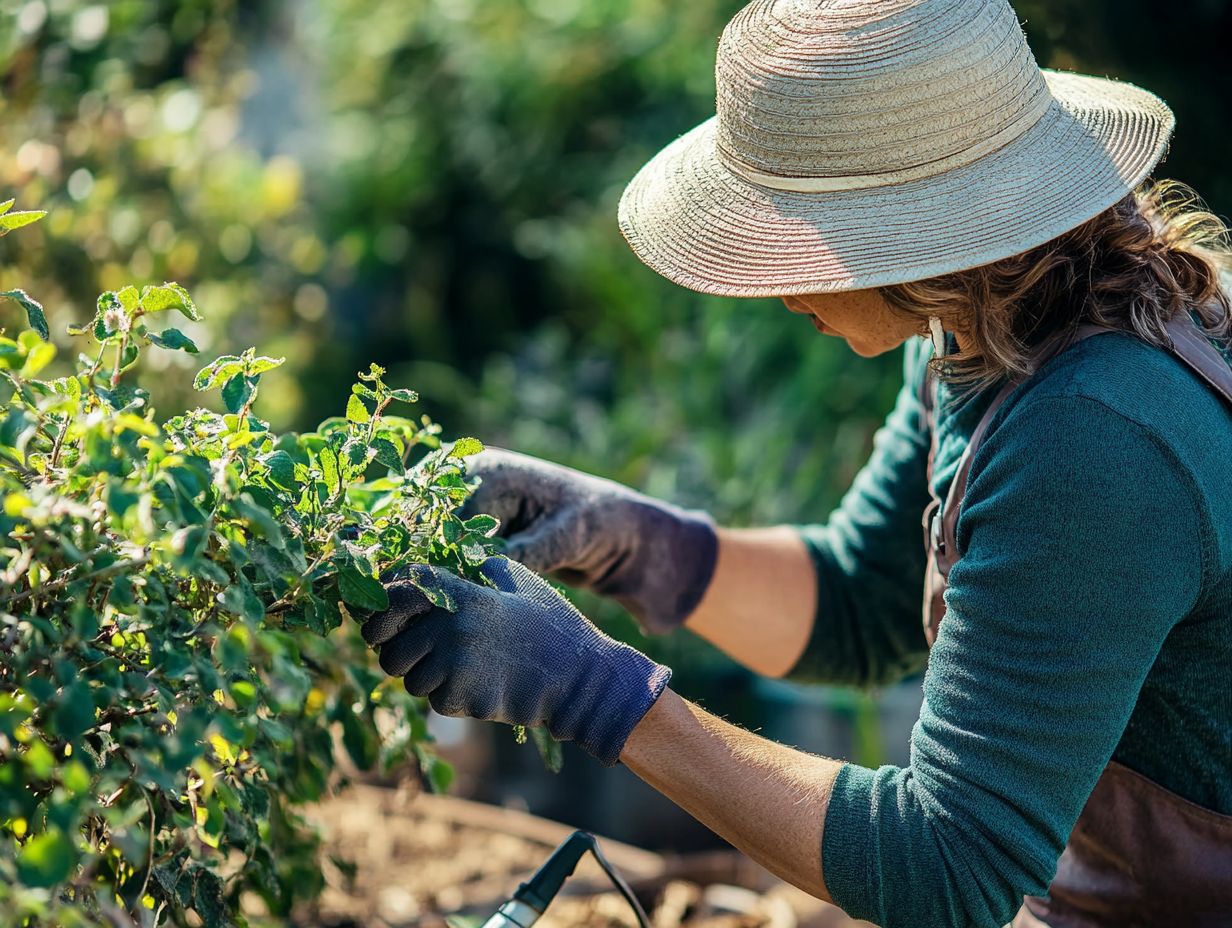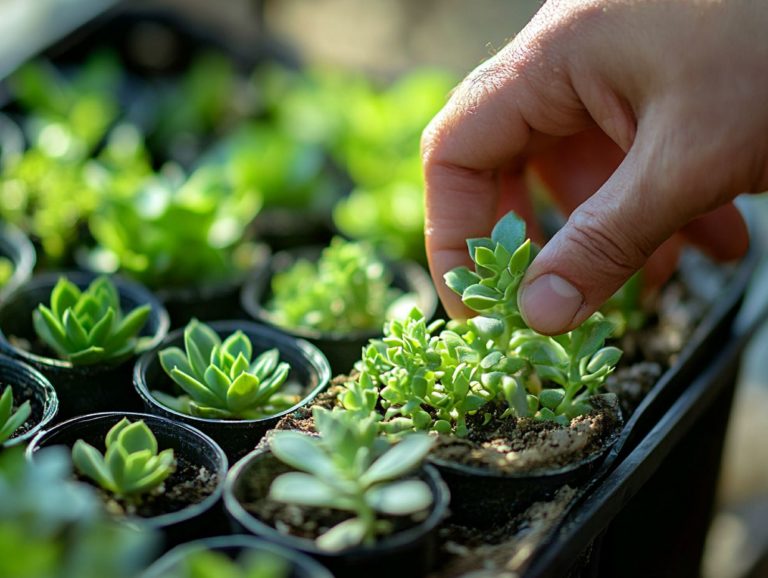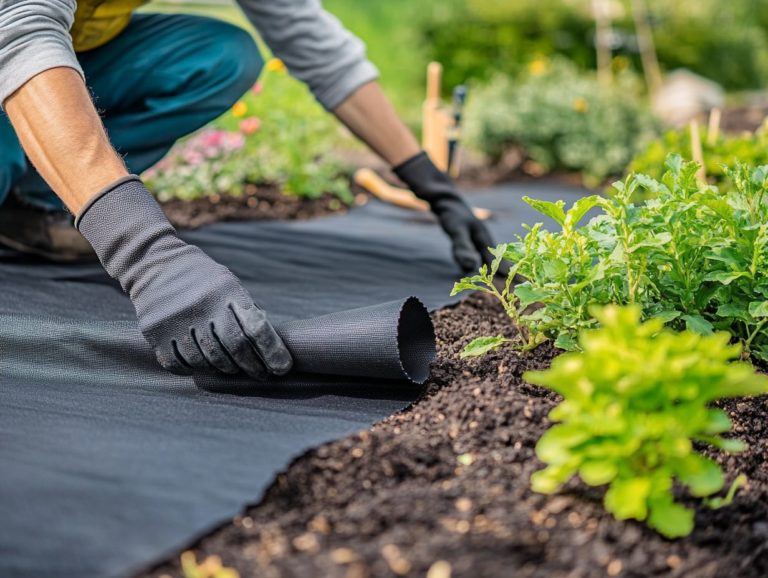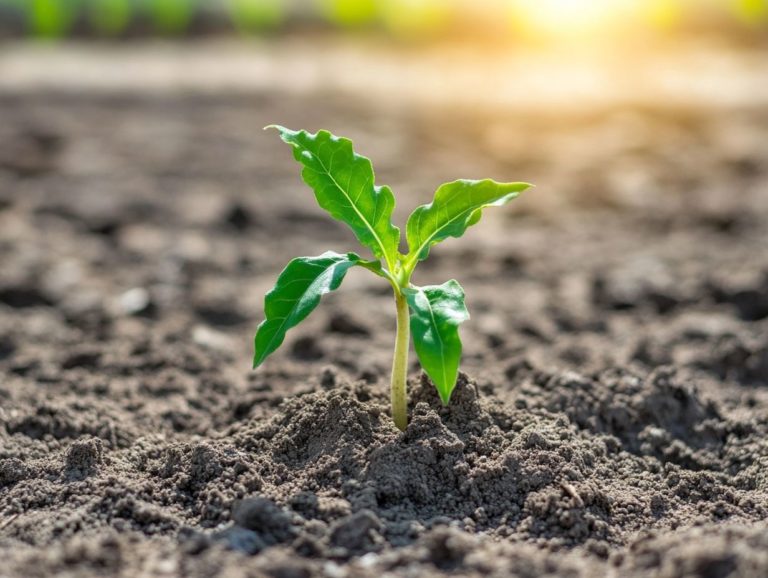Essential Pruning Techniques for Drought Plants
Drought-resistant plants possess exceptional adaptations that allow them to thrive in dry conditions, displaying remarkable traits that enable their survival.
To ensure their vitality, proper care and maintenance especially through pruning are essential. Discover why pruning is the secret to vibrant plants! This article highlights the benefits of pruning, the optimal times to prune, and the tools and techniques that will enhance your efforts.
Whether you re tending to trees, shrubs, or succulents, you ll discover practical strategies to help your drought-resistant plants thrive.
Join us as we reveal essential pruning techniques that will keep your green companions healthy and resilient.
Contents
- Key Takeaways:
- Understanding Drought-Resistant Plants
- Why Pruning is Important for Drought-Resistant Plants
- When to Prune Drought Plants
- Essential Tools and Techniques for Pruning Drought-Resistant Plants
- Pruning Strategies for Different Types of Drought Plants
- Maintaining Pruned Drought Plants
- Frequently Asked Questions
Key Takeaways:

- Understanding the unique characteristics and adaptations of drought-resistant plants is crucial for successful pruning.
- Proper pruning techniques can help drought-resistant plants better survive and thrive in harsh conditions.
- Different types of drought-resistant plants may require different pruning strategies, so it is important to choose the right tools and techniques for each plant.
Understanding Drought-Resistant Plants
Drought-resistant plants are specialized species that excel in dry conditions, showcasing distinctive characteristics and adaptations that allow them to thrive despite limited water resources.
These plants, including various shrubs, perennials, and annuals, possess features such as succulent leaves, deep root systems, and minimized foliage to reduce water loss. This remarkable resilience supports their survival and enriches healthier landscapes, providing both aesthetic charm and ecological advantages.
In this section, you will dive into the defining traits of drought-resistant flora and discover how they contribute to sustainable gardening.
Characteristics and Adaptations
Drought-resistant plants demonstrate fascinating adaptations that give them the power to conserve water and flourish in challenging environments.
These specialized features often include unique leaf structures, which may have a waxy coating or reduced surface area, effectively minimizing water loss. Their root systems can reach deep into the soil, allowing them to tap into moisture hidden beneath the surface. For example, many perennial species like yucca and agave develop robust root systems, enabling them to endure extended periods without rainfall.
In contrast, annuals such as the desert sweetflower have evolved to capitalize on fleeting rainfalls, rapidly germinating and completing their life cycle. These adaptations not only enhance their survival but also bolster their overall health and growth, making them vital players in drought-prone ecosystems.
Why Pruning is Important for Drought-Resistant Plants
Pruning is a vital practice for maintaining the health of drought-resistant plants, as it enhances their growth and aids in their adaptation to dry environments. By employing effective pruning techniques, you can improve air penetration and light exposure, significantly bolstering the overall health of resilient plants. Additionally, knowing about the essential tools for drought garden care can further support your gardening efforts, especially for shrubs and trees.
Proper trimming also removes diseased branches, fostering a stronger structure and encouraging healthier foliage. In this section, you will discover the various benefits and objectives of pruning for drought-resistant species.
Benefits and Goals of Pruning
The primary benefits of pruning drought-tolerant plants include improved health, enhanced growth, and disease prevention.
By strategically removing dead or overgrown branches, you promote better air circulation and direct the plant’s energy toward new, healthier shoots. For instance, thinning out congested branches can significantly reduce the risk of fungal infections, a common issue for water-sensitive species. Employing techniques like reducing the top of the plant to encourage growth not only helps maintain the plant’s aesthetic appeal but also ensures it remains vibrant and resilient.
Selectively pruning in early spring encourages robust growth, allowing drought-adapted plants such as succulents or native shrubs to thrive. This thoughtful care truly demonstrates how your efforts can lead to flourishing landscapes.
Get your pruning tools ready and transform your drought-resistant plants into thriving beauties today!
When to Prune Drought Plants

Timing is essential when it comes to pruning drought-resistant plants. Each season presents unique opportunities to enhance growth and vitality. By understanding the seasonal growth patterns of various species, including shrubs and perennials, you can establish an effective pruning schedule that aligns with the plants’ natural rhythms.
For example, summer pruning can be particularly beneficial. It encourages new foliage and minimizes the risk of disease in plants such as hydrangeas and dogwoods. Get ready to discover the best times to prune your drought-tolerant plants!
Seasonal Considerations
Understanding seasonal growth patterns helps maintain drought-tolerant plants, especially for establishing a pruning schedule. These resilient plants thrive in arid conditions and exhibit unique growth cycles significantly influenced by seasonal changes.
Many drought-tolerant species, such as rosemary and lavender, primarily bloom during the spring and summer months. Prune just before the growing season to encourage robust growth and a greater abundance of flowers.
Plants like desert sage benefit from pruning in late summer, promoting a healthier structure as they prepare for winter dormancy.
By paying close attention to these seasonal cues, you can enhance the overall health and aesthetic appeal of your drought-tolerant plants, ensuring they remain vibrant throughout the year.
Essential Tools and Techniques for Pruning Drought-Resistant Plants
Using the right tools and techniques is crucial for effectively pruning drought-resistant plants. For those looking to enhance their gardening methods, exploring water-saving gardening techniques for drought can be beneficial. Clean and precise cuts foster healthy growth, and pruning shears, loppers, and other sharp instruments are essential for achieving those small adjustments that profoundly influence a plant’s health and recovery.
In this section, you will discover a range of pruning tools and techniques that can be employed for optimal care of your drought-resistant flora.
Choosing the Right Tools
Selecting the right tools is essential for successful pruning. Pruning shears are one of the most important instruments in your gardening arsenal.
These shears excel at precision cutting, making them adept at handling smaller branches and delicate plants. You might also want to consider loppers for those thicker branches that can be overwhelming for shears.
Maintaining the sharpness of your tools is vital for efficiency and the health of your plants. Dull blades can crush stems instead of providing those clean, healthy cuts. When choosing your tools, consider the specific types of plants you’ll be working with. Bypass shears are perfect for softer stems, while anvil shears excel with dry, woody branches. Always prioritize comfort in your grips and ensure that your tools match the scale of your gardening projects.
Proper Pruning Techniques
Proper pruning techniques are essential for ensuring healthy growth and maintaining vitality in drought-resistant plants. To further enhance resilience, you can explore techniques for propagating drought plants, employing methods such as heading cuts, thinning cuts, and removal cuts.
Heading cuts involve trimming back stems to encourage bushier growth, particularly beneficial for shrubs struggling in dry conditions.
Thinning cuts reduce branch density, allowing more light and air to penetrate the interior crucial for photosynthesis and moisture retention.
Removal cuts eliminate dead or diseased wood, redirecting the plant’s energy toward healthy growth.
By implementing these techniques, you foster recovery and support overall development, making drought-resistant plants more robust against environmental challenges.
Pruning Strategies for Different Types of Drought Plants

Crafting customized pruning strategies for various drought-resistant plants is essential for fostering their health and supporting sustainable growth. Whether you’re working with shrubs, trees, or succulents, understanding the specific requirements of each plant type enables you to execute effective pruning.
This method boosts their ability to handle drought. In this section, you will discover best practices for pruning an array of drought-resistant species, ensuring they thrive in optimal health and growth.
Best Practices for Trees, Shrubs, and Succulents
Implementing best practices for pruning trees, shrubs, and succulents can significantly enhance their growth and resilience in drought conditions.
Understanding the unique requirements of each plant type is essential for effective maintenance. For example, trees that lose leaves in winter thrive when pruned in late winter or early spring, allowing them to direct their energy toward new growth.
On the other hand, trees that keep their leaves year-round appreciate a light trim in early fall to maintain their shape while avoiding undue stress on the plant.
In terms of succulents, careful pruning during their active growth period in spring and summer is key. Removing dead leaves or stems promotes better airflow and minimizes the risk of disease.
By tailoring your pruning techniques and schedules to these specific characteristics, you can ensure that your plants not only survive but truly flourish, even in arid environments.
Maintaining Pruned Drought Plants
Maintaining pruned drought plants is essential for ensuring their continued health and resilience, particularly in challenging arid conditions. After pruning, implementing proper care practices such as strategic watering and effective mulching can significantly boost their recovery and growth. For more insights, consider these essential tips for planting drought-tolerant species.
Understanding the specific needs of various drought plants is crucial to their long-term vitality. In this section, you will discover top tools for caring for drought plants that will enhance your ability to nurture and maintain pruned drought plants effectively.
Watering and Care Tips
Watering and care are essential for maintaining the health of your pruned drought-tolerant plants. These crucial practices not only ensure that your plants receive the hydration they need but also significantly enhance their resilience. For more insights, check out these landscape maintenance tips for drought areas that can help you thrive in challenging environmental conditions.
Act now to improve your drought-resistant plants! Using deep watering methods will encourage roots to dive deep for moisture, enabling them to access it more effectively.
Regularly monitoring soil moisture is equally important. Utilizing tools like moisture meters can provide precise readings, helping you avoid the pitfalls of overwatering and underwatering.
Mulching around the base of your plants can help retain soil moisture and regulate temperature, creating an ideal environment for growth.
Frequently Asked Questions
What are essential pruning techniques for drought plants?

Essential pruning techniques for drought-resistant plants include regular monitoring, strategic pruning, and proper timing.
Wondering why it’s important to prune drought plants?
Pruning drought-resistant plants promotes healthy growth, improves drought tolerance, and helps conserve water, especially when considering winter care for drought-resistant plants.
Wondering how often to prune?
The frequency of pruning for drought plants depends on their individual needs, but it is generally recommended to prune once or twice a year.
What tools do I need for pruning drought plants?
The essential tools for pruning drought plants include sharp pruning shears, loppers, and a pruning saw for larger branches. Additionally, following tips for maintaining plant health in drought can enhance your gardening efforts.
When is the best time to prune drought plants?
The best time to prune drought plants is during their dormant season, typically in late winter or early spring before new growth appears.
Start pruning today to ensure your plants thrive!
Can I Prune Plants During a Drought?
Pruning plants during a drought is generally not a good idea. It can stress and damage them.
If you must prune, only remove minimal growth. Be sure to water the plant before and after pruning to help it recover.






